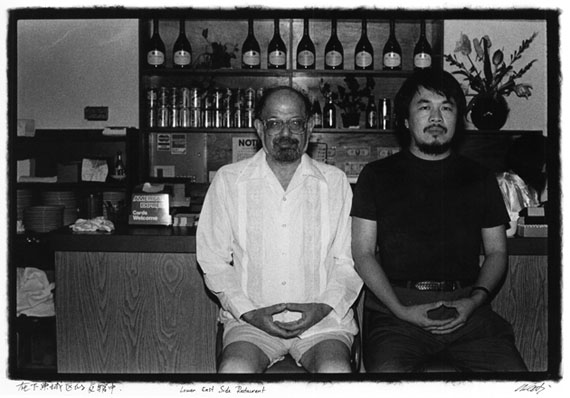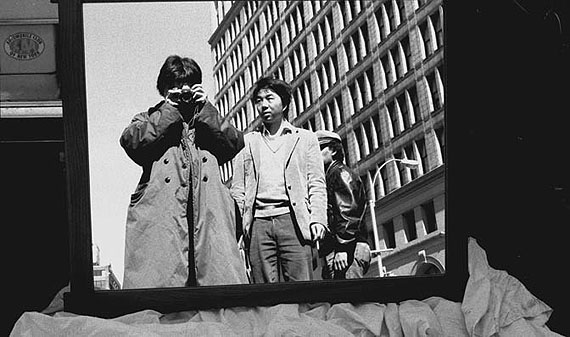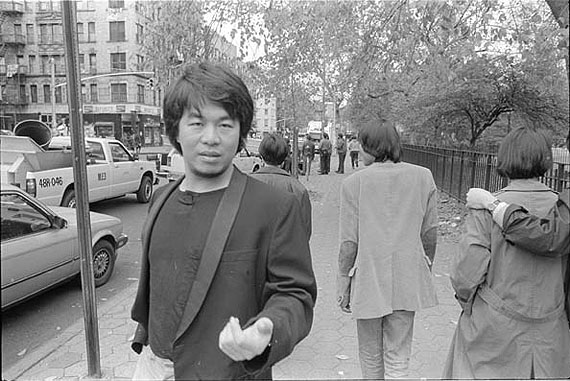
© Ai Weiwei
Courtesy Ai Weiwei Studio
Ai Weiwei »
NEW YORK 1983-1993
Exhibition: 16 Aug – 21 Oct 2012
Thu 16 Aug 18:00
Ernst Múzeum
Nagymezö u.8
1065 Budapest
Műcsarnok - Kunsthalle Budapest
56-Hősök tere
Budapest
06-1-4607000
info@mucsarnok.hu
www.mucsarnok.hu
Tue-Sun 10-18 . Thu 12-20

© Ai Weiwei
Courtesy Ai Weiwei Studio
AI WEIWEI | NEW YORK 1983–1993
Ernst Múzeum Budapest
August 16th – October 21st, 2012
This exhibition is a cooperation between Ai Weiwei Studio, ALEXANDER OCHS GALLERIES BERLIN | BEIJING and Mücsarnok / Kunsthalle Budapest.
www.alexanderochs-galleries.com
After exhibitions at Martin-Gropius-Bau Berlin and at Moscow Multimedia Art Museum, the Ernst Múzeum in Budapest/Hungary is showing photographs from the period 1983 to 1993 spent by Chinese artist Ai Weiwei in New York. More than 10,000 photos emerged during this time. Ai acted as curator selecting what will be exhibited here. For the young Ai, born in 1957, this extended period of stay in the USA was very influential on the style of his future artistic works. After being in New York, Ai first of all returned to China as his father, the very famous author Ai Qing whose poems every Chinese schoolchild learns by heart, was on his deathbed.
Today, Ai Weiwei is one of the most famous Chinese artists of contemporary times. While living in New York, he became friends with Allen Ginsberg. Many artists who are now famous in China visited him there and Ai photographed them. He became familiar with the works of Joseph Beuys, whose ideas on Social Plastic are recognisable in Ai's work today. Andy Warhol was also an influence.
Ai was not yet famous back then in New York, living in a tiny apartment in the East Village. He was an active member of the Chinese community of artists and intellectuals in the area’s avant-garde scene. In the 1980s, New York was a place of freedom from the repression that artists from China had experienced in their home country. After the death of Mao Zedong in 1976, the situation became a little more relaxed for China’s artists, but the country was, and continues to be, governed by rigid notions of what art should be like and about whom art is to serve.
Ai captured life in the New York of the eighties with his camera. The result is a series of unique documents bearing witness to an artistically and politically exciting period seen through the eyes of an artist from China. And the viewer can already recognise the beginnings of Ai Weiwei’s concept art in these early photographs. The subjects are varied like life in New York – photos of street fights in Tompkins Square Park, transvestites at the Wigstock Festival, portraits of Chinese and American artists, intellectuals and friends.
The photos lay around forgotten for many years. Thousands of not yet developed negatives remained hidden from view in old cardboard boxes. In 1993, following Ai Weiwei’s return to China, he told the Chinese artist Rong Rong about them and it is thanks to him that Ai agreed to an exhibition at the Three Shadows Photography Art Centre in Beijing in the year 2009. In the summer of 2010, a first publication appeared in China with the support of Christophe W. Mao and funded by the Mattawin Company.
Ai has always understood his art as political: concept art, performance, photography – the breadth of the forms of his artistic expression has helped to make him China’s most important artist. Duchamp, Dadaism, Social Sculpture and Andy Warhol have influenced him. His blog has been turned into a successful book in Europe and America. His exhibitions in the USA, Europe and Asia are legendary. He became popular in Germany through his participation in documenta 12 in the year 2007. His work is represented in the most important museums in the world: the Tate Modern in London, the Museum of Modern Art in New York, the State Museums in Berlin as well as museums in San Francisco and in Los Angeles.
AI WEIWEI | NEW YORK 1983–1993
Ernst Múzeum Budapest
16. August – 21. Oktober 2012
Diese Ausstellung ist eine Kooperation von Ai Weiwei Studio, ALEXANDER OCHS GALLERIES BERLIN | BEIJING und Mücsarnok / Kunsthalle Budapest.
www.alexanderochs-galleries.com
Das Ernst Múzeum in Budapest zeigt, nach Ausstellungen im Martin-Gropius-Bau Berlin und im Multimedia Art Museum in Moskau, Fotografien aus der Zeit von 1983 bis 1993, die der chinesische Künstler Ai Weiwei in New York verbrachte. Über 10.000 Aufnahmen entstanden damals. Ai hat eine Auswahl getroffen und die Ausstellung kuratiert. Für den jungen Ai, geboren 1957, war der lange Aufenthalt in den USA stilprägend für seine weitere künstlerische Laufbahn. Aus New York kehrte Ai erst wieder nach China zurück, als sein Vater, der in China hochberühmte Schriftsteller Ai Qing – jedes Schulkind lernt seine Gedichte auswendig – im Sterben lag.
Heute ist Ai Weiwei der bekannteste chinesische Künstler der Gegenwart. In New York war er befreundet mit Allen Ginsberg. Viele der heute in China berühmten Künstler besuchten ihn damals dort. Ai fotografierte sie. Er lernte die Arbeiten von Joseph Beuys kennen, dessen Vorstellungen von Sozialer Plastik im heutigen Werk von Ai erkennbar ist. Andy Warhol beeinflusste ihn.
In New York, Ai war damals noch nicht berühmt, lebte er in einer winzigen Wohnung im Stadtteil East Village. Er war aktives Mitglied der chinesischen Künstler- und Intellektuellengemeinde in der Avantgarde-Szene des Viertels. In den 1980er Jahren war New York für die Künstler aus China auch ein Ort der Befreiung von jenen Repressionen, denen sie in ihrer Heimat ausgesetzt waren. Nach dem Tod von Mao Tse-tung im Jahre 1976 wurden die Verhältnisse für die Künstler Chinas zwar etwas freier, doch noch immer regier(t)en im Land rigide Vorstellungen von dem, was Kunst zu sein und wem Kunst zu dienen habe.
Mit seiner Kamera fing Ai das Leben im New York der 1980er Jahre ein. Einzigartige Dokumente einer künstlerisch und politisch aufregenden Zeit entstanden, wahrgenommen mit den Augen eines Künstlers aus China. Auch Anfänge der Konzeptkunst Ai Weiweis sind in den Aufnahmen erkennbar. Die Sujets sind vielfältig wie das Leben in New York: Bilder von Straßenschlachten im Tompkins Square Park, Transvestiten beim Wigstock-Festival, Porträts von chinesischen und amerikanischen Künstlern, Intellektuellen und Freunden.
Viele Jahre schienen die Fotografien vergessen. Tausende oft nicht entwickelte Negative schlummerten in einem alten Karton.1993, nach Ai Weiweis Rückkehr nach China erzählte er dem chinesischen Künstler Rong Rong von deren Existenz und es ist ihm zu verdanken, dass Ai einer Ausstellung im Three Shadows Photography Art Centre Beijing im Jahr 2009 zustimmte. Im Sommer 2010 erschien eine erste unter Mitwirkung von Christophe W. Mao und der Mattawin Company geförderte Publikation in China.
Seine Kunst hat Ai immer als politisch verstanden: Konzeptkunst, Performance, Fotografie – die Breite seiner künstlerischen Ausdrucksformen halfen, ihn zum wichtigsten Künstler Chinas zu machen. Duchamp, Dadaismus, Soziale Plastik und Andy Warhol beeinflussten ihn. Sein Blog ist als erfolgreiches Buch auf dem Markt in Europa und Amerika. Seine Ausstellungen in USA, Europa und Asien sind legendär. Seine Beteiligung an der documenta 12 im Jahr 2007 machte ihn in Deutschland populär. Sein Werk ist in vielen wichtigen Museen der Welt vertreten: in der Tate Modern in London, im Museum of Modern Art New York, in den Staatlichen Museen zu Berlin, in San Francisco und Los Angeles.

© Ai Weiwei
Courtesy Ai Weiwei Studio